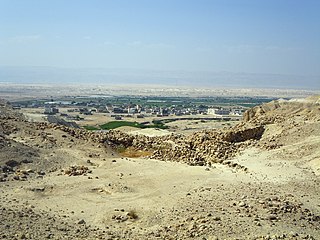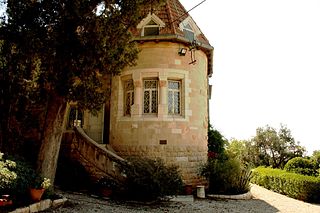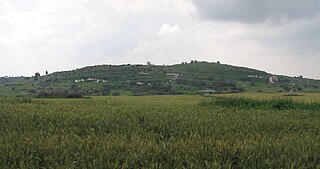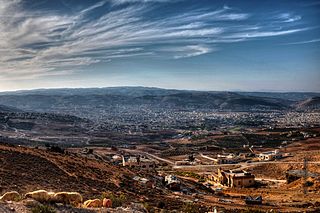Related Research Articles

Heshbon were at least two different ancient towns located east of the Jordan River in what is now the Kingdom of Jordan, historically within the territories of ancient Ammon.

Dhiban, known to the Moabites as Dibon, is a Jordanian town located in Madaba Governorate, approximately 70 kilometres south of Amman and east of the Dead Sea. Previously nomadic, the modern community settled the town in the 1950s. Dhiban's current population is about 15,000, with many working in the army, government agencies, or in seasonal agricultural production. A number of young people study in nearby universities in Karak, Madaba, and Amman. Most inhabitants practice Islam.

Bab edh-Dhra is the site of an Early Bronze Age city located near the Dead Sea, on the south bank of Wadi Kerak with dates in the EB IB, EB II, EB III and EB IVA. Bab edh-Dhra was discovered in 1924 on an expedition led by William F. Albright.
The Biblical Archaeology Society was established in 1974 by American lawyer Hershel Shanks, as a non-sectarian organisation that supports and promotes biblical archaeology. Its current publications include the Biblical Archaeology Review, whilst previously circulating the Bible Review (1985–2005) and Archaeology Odyssey (1998–2006). The Biblical Archaeology Society also publishes books about biblical archaeology aimed at a general readership. The Society has, for more than 30 years, run seminars and tours offering an opportunity to learn directly from world-renowned archaeologists and scholars. It also produces videos (DVD) and CDs on archaeology and biblical archaeology.

The German Protestant Institute of Archaeology (GPIA), Research Unit of the German Archaeological Institute, founded in 1900 is one of the most important biblical archaeological institutes in the Near East. Its German name is Deutsches Evangelisches Institut für Altertumswissenschaft des Heiligen Landes.

Livias was a city in Transjordan in Classical Antiquity. In the writings of Josephus (English translation), the name is presented as Julias.
Al-Yadudah is a town in the Amman Governorate in northwestern Jordan, located south of the capital Amman.

Siegfried Herbert Horn was a Seventh-day Adventist archaeologist and Bible scholar. He is best known for his excavations at Heshbon in Jordan and Shechem in the West Bank. He was Professor of History of Antiquity at the Seventh-day Adventist Theological Seminary in Berrien Springs, Michigan. The Siegfried H. Horn Museum at Andrews University was named in his honor. An educator of wide-ranging interests and abilities, his areas of specialty were Ancient Near Eastern chronology and archaeology.

Tell es-Safi was an Arab Palestinian village, located on the southern banks of Wadi 'Ajjur, 35 kilometers (22 mi) northwest of Hebron which had its Arab population expelled during the 1948 Arab-Israeli war on orders of Shimon Avidan, commander of the Givati Brigade.
Lawrence "Larry" T. Geraty is an American academic who served as the second President of La Sierra University in Riverside, California. He completed his undergraduate education in theology at Pacific Union College, his bachelor of divinity and master of arts in religion from Andrews University, and received a doctorate in biblical studies from Harvard University.

Tall Jawa is an archaeological and historical site in central Jordan.

Tall al-’Umayri is an archaeological dig site in western Jordan that dates from the Early Bronze Age to the Hellenistic period. It is located near the modern capital of Amman, and is significant for its well-preserved evidence of a temple, as well as archaeological evidence of a network of small farms believed to produce wine. Excavations were proceeding as of 2014.
Jalul is an archaeological site and small village in the Amman Governorate in northwestern Jordan.
Hisban is a town in the Amman Governorate of north-western Jordan. Tell Hisban is one of a few possible locations thought to be biblical Heshbon.

Burton MacDonald is a Canadian biblical archaeologist specialising in the archaeology of Jordan. He has been a professor at St. Francis Xavier University since 1965 and is currently Professor Emeritus in the Religious Studies department.

Tell el-Hammam is an archaeological site in Jordan, in the eastern part of the lower Jordan Valley close to the mouth of the Jordan River. The site has substantial remains from the Chalcolithic, Early, Intermediate and Middle Bronze Age, and from Iron Age II. There are different attempts at identifying the site with a biblical city.

The Balqa, known colloquially as the Balga, is a geographic region in central Jordan generally defined as the highlands east of the Jordan Valley in between the Zarqa River to the north and the Wadi Mujib gorge to the south.
Khirbat Ataruz or Ataroth is an archaeological site in Madaba Governorate, Jordan. The site was settled during the Iron Age, Hellenistic, Roman and Islamic periods, with most findings dating from the Iron Age.
The Heshbon Expedition is the name commonly used to refer to five seasons of archaeological excavations looking for biblical Heshbon at Tall Hisban in Jordan. The excavations were carried out by a team of archaeologists from Andrews University between 1968 and 1976. The first three campaigns were led by Siegfried H. Horn of the Theological Seminary at Andrews University and Roger S. Boraas of Upsala College and last two by Lawrence T. Geraty, Horn's successor at Andrews, and Boraas.
Oystein Sakala LaBianca is a National Geographic Explorer and director of the Hisban Cultural Heritage Project at Tall Hisban in Jordan. He is notable for having introduced new interpretive tools for studying long-term processes of cultural production and change in the Eastern Mediterranean and for pioneering community archaeology in the region.
References
- ↑ "The longest ongoing archaeological project, Madaba Plains Project, celebrates 50 years of research". Jordan Times. July 12, 2018. Retrieved June 27, 2022.
- ↑ Geraty, Lawrence T.; Herr, Larry G.; LaBianca, Øystein S.; Battenfield, James R.; Boling, Robert G.; Clark, Douglas R.; Lawlor, John I.; Mitchel, Larry A.; Younker, Randall W. (1986). "Madaba Plains Project: A Preliminary Report of the 1984 Season at Tell el-'Umeiri and Vicinity". Bulletin of the American Schools of Oriental Research. Supplementary Studies (24): 117–144. ISSN 0145-3661.
- ↑ Younker, Randy (1989). An Overview of Goals, Methods, and Findings. Andrews University.
- 1 2 LaBianca, Øystein S. (1991). "Food systems research: An overview and a case study from Madaba plains, Jordan". Food and Foodways. 4 (3–4): 221. ISSN 0740-9710.
- 1 2 "The Madaba Plains Project: Forty Years of Archaeological Research into Jordan's Past". Routledge & CRC Press. Retrieved June 27, 2022.
- ↑ LaBianca, Øystein Sakala; Haynes, Lori A.; Hubbard, Lorita E.; Running, Leona Glidden (1990). Sedentarization and nomadization: food system cycles at Hesban and vicinity in Transjordan. Hesban. Andrews University. Berrien Springs, MI: Institute of Archaeology : Andrews University Press. ISBN 978-0-943872-00-1.
- ↑ Levy, Thomas Evan; Daviau, P. M. Michele; Younker, Randall W., "Tall Hisban: Palimpsest of Great and Little Traditions of Transjordan and the Ancient Near East", Crossing Jordan, doi:10.4324/9781315478579-22/tall-hisban-palimpsest-great-little-traditions-transjordan-ancient-near-east-thomas-evan-levy-michele-daviau-randall-younker , retrieved June 27, 2022
- ↑ Christopherson, Gary L. (2000). "In pursuit of the longue duree: Usinga geographic information system to model archaeological settlement patternsin the region of Tell el-'Umeiri, Jordan".
{{cite journal}}: Cite journal requires|journal=(help) - ↑ Beikmann, Stanley. "The Application of Botanic Garden Interpretive Methodology to Archaeological Site Interpretation".
{{cite journal}}: Cite journal requires|journal=(help) - ↑ "Italian-Jordanian architect pushes for community archaeology". Jordan Times. August 9, 2017. Retrieved June 28, 2022.
- ↑ "Publications | Madaba Plains Project: Jalul" . Retrieved June 27, 2022.
- ↑ "Madaba Plains Project Publication Series". Institute of Archaeology & Siegfried H. Horn Museum. December 18, 2014. Retrieved June 27, 2022.
- ↑ "Hesban Series | Madaba Plains Project: Hisban" . Retrieved June 27, 2022.